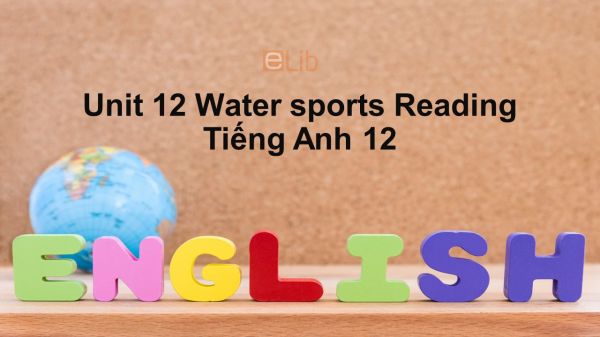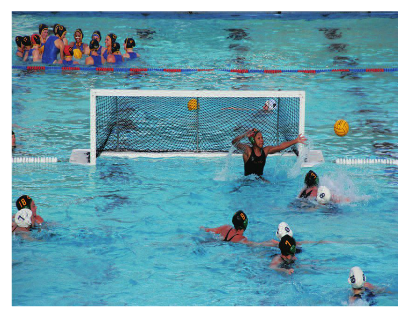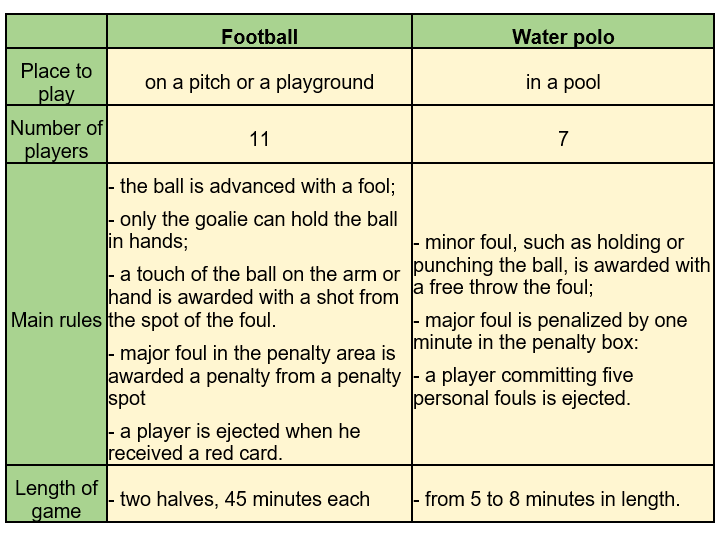Unit 12 lớp 12: Water Sports-Reading
Bài học Unit 12 Lớp 12 Water Sports phần Reading giúp các em có một cái nhìn tổng quan nhất về chủ đề mình sẽ được tìm hiểu xuyên suốt trong Unit này. Ở kĩ năng đọc hiểu này các em sẽ làm quen với những bộ môn thể thao mới về cách chơi, luật chơi cũng như những điểm đặc biệt của mỗi môn thể thao khác nhau.
Mục lục nội dung

Unit 12 lớp 12: Water Sports-Reading
1. Before You Read Unit 12 lớp 12
Work in pairs. Look at the picture and answer the questions (Làm việc từng đôi. Nhìn hình và trả lời câu hỏi)
1. Can you name the sport in the picture? (Bạn có thể nêu tên môn thể thao trong bức tranh?)
2. Where is it played? (Nó được chơi ở đâu?)
3. How do people play it? (Mọi người chơi nó như thế nào?)
Guide to answer
1. It’s water polo. (Đó là bóng nước.)
2. It's played in a pool. (Nó được chơi trong một hồ bơi.)
3. People play it with a ball, which is passed to each other by hand or advanced with the head over the water between the player’s arms. (Mọi người chơi nó bằng một quả bóng, được truyền cho nhau bằng tay hoặc nâng cao đầu trên mặt nước giữa hai cánh tay của người chơi.)
2. While You Read Unit 12 lớp 12
Read the passage and do the tasks that follow (Đọc đoạn văn và làm bài tập kèm theo)
Water polo is played in a pool 1.8 metres deep, 30 metres long and 20 metres wide, with a goal 3 metres high and at least 0.9 metre above the water. The goal is marked by vertical posts, a crossbar and a net.
There are seven players per team, six swimmers and a goalie. The home team wears white caps, the visiting team blue ones and the goalies wear red caps with the number 1 in white.
Like football, the game begins with the ball in the centre of the pool and both teams sprint for it from their own goal lines. The ball can be advanced by passing with one hand or swimming with the head above the water and the ball between the arms so it rides on the wave created by the swimmer’s head. No player except the goalie can hold the ball with both hands.
Defensive players are not allowed to interfere with the opponent’s movements unless the player is holding the ball. Major fouls are penalized by one minute in the penalty box and a player is ejected after committing five personal fouls.
For minor fouls, such as holding or punching the ball, a free throw is awarded from the spot of the foul. At least two players must touch the ball after a free throw before a goal can be scored.
A game is divided into quarters ranging from five to eight minutes in length. After a tie, there are two overtime periods of three minutes each. If the game is still tied after the overtime periods, two teams continue to play 3-minute overtime until the referee’s decision is made.
Tạm dịch
Môn bóng nước được chơi trong hồ (bơi) sâu 1,8 mét, dài 30 mét và rộng 20 mét. Với khung thành (cầu môn) cao 3 mét và cao trên mặt nước ít nhất 0,9 mét. Khung thành được đánh dấu bằng hai trụ thẳng đứng, một thanh ngang và lưới.
Có 7 cầu thủ ở mỗi đội: sáu tay bơi và một thủ môn. Đội nhà đội mũ trắng, đội khách đội mũ xanh dương và các thủ môn đội mũ đỏ với số 1 màu trắng.
Giống như bóng đá, cuộc thi đấu bắt đầu với trái banh ở trung tâm hồ bơi và hai đội bơi nhanh đến nó từ đường khung thành của mình. Quá banh có thể được đưa tới trước do chuyền bằng tay hoặc bơi với đầu trên nước và quả banh giữa hai cánh tay, do đó trái banh lướt trên sóng tạo nên bởi đầu của cầu thủ. Không một cầu thủ nào trừ thủ môn có thề giữ banh với cả hai tay.
Hậu vệ không được can thiệp vào di chuyển của đốì phướng trừ phi cầu thủ đang giữ banh. Những lỗi nặng bị phạt một phút trong vùng cấm địa và một cầu thủ bị đuổi ra ngoài sau khi tự mình phạm năm lỗi.
Đối với lỗi nhẹ, như cầm hoặc bấm bóng, một quả ném tự do được thưởng từ điểm phạm lỗi. Ít nhất hai cầu thủ phải chạm bóng sau quả ném tự do trước khi bàn thắng được ghi
Một trận đấu được chia thành các hiệp từ 5 đến 8 phút. Sau một trận hòa, có hai lần thêm giờ, mỗi lần 3 phút. Nếu trận đấu vẫn còn hòa sau những lần thêm giờ, hai đội tiếp tục chơi thêm một lần thêm giờ 3 phút cho đến khi trọng tài quyết định.
2.1. Task 1 Unit 12 lớp 12
Work in pairs. Match the words in column A with their meanings in column B (Làm việc từng đôi. Ghép những từ ở cột A với nghĩa của chứng ở cột B)
Guide to answer
1 - e
opponent: someone who tries to defeat another person in a competition
(đối thủ: một người cố gắng để đánh bại một người khác trong một cuộc thi)
2 - c
penalize: to punish a team or player who breaks the rules
(xử phạt: để trừng phạt một đội hoặc người chơi vi phạm các quy tắc)
3 - a
eject: to make someone leave a game
(đuổi: để làm cho ai đó rời một trò chơi)
4 - b
foul: an action in sports that is against the rules
(phạm lỗi: một hành động trong thể thao đó là trái với các quy tắc)
5 - d
tie: a situation in a game when two teams have the same scores
(hòa: một tình huống trong một trò chơi khi hai đội có cùng số điểm)
2.2. Task 2 Unit 12 lớp 12
Complete the following sentences, using the information from the passage (Điền những câu sau, dùng thông tin từ đoạn văn)
1. Water polo is played in a pool……….metres deep,……....long and……….wide.
2. The home team wears………, the visiting team wears ……………and the goalies wear……………..
3. Both teams sprint for the ball from…………….
4. A free throw is awarded for minor fouls, such as…………….
5. A game is divided into quarters ranging from………….in length.
Guide to answer
1. Water polo is played in a pool 1.8 metres deep, 30 metres long and 20 metres wide.
(Bóng nước được chơi trong một hồ bơi sâu 1,8 mét, dài 30 mét và rộng 20 mét.)
2. The home team wears white caps, the visiting team wears blue caps and the goalies wear red caps with the number 1 in white.
(Đội chủ nhà đội mũ trắng, đội khách đội mũ xanh và thủ môn đội mũ đỏ với số 1 màu trắng.)
3. Both teams sprint for the ball from their own goal lines.
(Cả hai đội đẩy quả bóng từ vạch xuất phát.)
4. A free throw is awarded for minor fouls, such as holding or punching the ball.
(Một quả ném phạt tự do được trao cho những pha phạm lỗi nhỏ, chẳng hạn như cầm hay đấm vào bóng.)
5. A game is divided into quarters ranging from five to eight minutes in length.
(Một trò chơi được chia thành các hiêp từ 5 đến 8 phút.)
2.3. Task 3 Unit 12 lớp 12
Work in pairs. Ask and answer the following questions (Làm việc từng đôi. Hỏi và trả lời những câu hỏi sau)
1. Where can people play water polo? (Người ta có thể chơi bóng nước ở đâu?)
2. Where is the ball when the game starts? (Bóng ở đâu khi trận đấu bắt đầu?)
3. How can the ball be advanced? (Làm thế nào để quả bóng được nâng cao?)
4. Which players are allowed to hold the ball with both hands? (Người chơi nào được phép giữ cả hai tay?)
5. What happens to a player who commits five personal fouls? (Điều gì xảy ra với một cầu thủ phạm lỗi cá nhân?)
Guide to answer
1. People can play it in a pool.
(Mọi người có thể chơi nó trong một hồ bơi.)
2. It is in the centre of the pool.
(Đó là trong trung tâm của hồ bơi.)
3. Ball can be advanced by passing with in a hand or swimming with the head above the water and the ball between the arms so it rides on the waves created by the swimmer's head.
(Bóng có thể được nâng cao bằng cách truyền đi bằng tay hoặc bơi với đầu trên mặt nước và bóng giữa các cánh tay để nó cưỡi trên sóng tạo ra bởi đầu của người bơi.)
4. Only the goalies can hold the ball with both hands.
(Chỉ có những cầu thủ mới được giữ quả bóng bằng cả hai tay.)
5. He is ejected from the same after committing five personal fouls.
(Anh ta bị đuổi ra khỏi cùng một lúc sau khi thừa nhận 5 lỗi cá nhân.)
3. After You Read Unit 12 lớp 12
Work in groups. Make a comparison between football and water polo, using the following suggestions (Làm việc từng nhóm. So sánh giữa bóng đá và bóng nước, dùng những gợi ý sau)
- Place to play (nơi để chơi)
- Number of players (số lượng người chơi)
- Main rules (luật chính)
- Length of game (thời gian chơi)
Guide to answer
4. Practice Task 1
Read the passage carefully and decide these statements are True, False or No information (Đọc các đoạn văn sau và xem các phát biểu sau True, False hay No information)
Water sports are as challenging as they are fun. Although water sports are not as popular as basketball or football, activities such as parasailing, water skiing, water polo, wakeboarding, jet skiing and competitive swimming interest many people. Ail water sports have an element of danger involved, which is why it is important to follow these safety tips before you dive in.
Step 1: Learn how to swim. Sure, it seems obvious, but it is also extremely important. Do not even think about skiing, tubing, wakeboarding or water polo if you cannot stay afloat in water deeper than your height.
Step 2: Check your equipment and your life safety tools. Count your life vests and have floatation devices nearby. If you are engaging in a sport that requires a lot of equipment, such as wakeboarding, go over every piece to ensure proper functioning.
Step 3: Be physically fit. Put your pride aside and get in shape. Most water sports are incredibly strenuous and require the player to have physical endurance. It can be dangerous to participate in a water sport, such as water skiing or wakeboarding, when your body isn't ready.
Step 4: Save the tricks for the professionals. If you are an amateur, do not attempt water sport tricks. It is tempting to push to the next level with sports like skiing and sailing, but train heavily first.
Step 5: Recruit a spotter. When you do water sports, always have an extra person on hand to spot for you. This includes indoor sports like' water polo, diving and competitive swimming.
T F N.I
.png)
.png)
.png) 1. Water sports are much more popular than basket ball and football.
1. Water sports are much more popular than basket ball and football.
.png)
.png)
.png) 2. Sometimes it is dangerous to playa water sport.
2. Sometimes it is dangerous to playa water sport.
.png)
.png)
.png) 3. The first thing you have to do is to learn how to swim if you want to take up a water sport.
3. The first thing you have to do is to learn how to swim if you want to take up a water sport.
.png)
.png)
.png) 4. You need to have a boat right beside all the time if you want to take up a water sport.
4. You need to have a boat right beside all the time if you want to take up a water sport.
.png)
.png)
.png) 5. There are tricks which amateur players cannot play.
5. There are tricks which amateur players cannot play.
5. Practice Task 2
Fill in each numbered blank with one suitable word or phrase (Điền vào chỗ trống với một từ hay cụm từ phù hợp)
Water polo is a rapidly growing sport in the United States and internationally as (1) ______. For anyone involved in playing or being a spectator, it is important to understand the rules of the game.
Each team (2) ______ of one goalie and six field players. Each field player plays both offense and defense, and the goalie is not allowed on the other half of the pool. There are many different arrangements of players in front of the goal. The (3) ______ of the players depends on the play that is being run, similar to basketball or hockey.
One important rule is that the ball can only be handled by one hand at a time. If a player (4) ______ the ball, which is the size of a volley ball, yellow and with rubber grip, with both hands, the referee calls a turnover and the possession of the ball goes to the opposing team.
The playing time, (5) ______ on the rules of play and the level of competition. Usually, men play four 7-minute quarters while women play four 6-minute quarters. Teams are usually allowed 2 time outs per game, but this may vary. (6) ______ consist of swimsuits for both men and women, as well as a cap on the head with plastic ear protectors and the player's number on both sides. Visiting teams wear lighter color caps, while home wears the darker color. In (7) ______, one point is given for each time the ball is thrown into the goal, and in some leagues there is a 2-point line several meters out of the goal. Each quarter begins with a (8) ______ in which the fastest members of each team race toward the ball, which is placed at the halfway point on the water by the referee.
Water polo is an (9) ______, challenging, and fun sport. It is full contact and its competitiveness cannot be underestimated. The game is great to watch and (10) ______ better to play. You may not imagine what goes on underwater that no one, especially not the referee, can see. Water polo is a growing sport for good reason, and it may soon be one of the leading sports for both men and women's athletics.
6. Conclusion
Qua bài học này các em cần ghi nhớ các từ vựng quan trọng sau
- water polo (n): môn bóng nước
- tie (n): trận hòa
- vertical (adj): phương thẳng đứng
- foul (n): phạm luật
- oppenent (n): đối thủ, đối phương
- penalty (n): hình phạt
- eject (v): tống ra, đuổi ra
- goalie (n): người giữ khung thành
- Defensive player (n): cầu thủ phòng thủ
- interfere with (v): can thiệp
- penalize (v): xử phạt




